Maintenance
Perform the routine maintenance actions listed below. Reduce the maintenance intervals if the inverter is located in a relatively harsh
environment. Any other maintenance and repairs must only be performed by qualified personnel.
Troubleshooting
In the event of a problem or malfunction in the system, the built-in self-diagnostics will automatically display messages to inform you of
faults, warnings and maintenance reminders.
Push the left softkey to hide each message from the screen. If there are several active messages, you must hide the most recent
message to see other active messages.
Further information
More detailed information about the PVS300 inverter can be found in the PVS300 product manual (3AUA0000096321 [English]),
supplied with the inverter. The Product manual can be found in www.abb.com/solar
by entering the document code in the search field.
Safety
WARNING! Ignoring the following instructions can cause injury or death, or damage to the equipment.
• Never attempt to repair a malfunctioning unit yourself. The inverter is not field repairable.
• Do not obstruct the inverter cooling air inlets and outlets.
Refer to the PVS300 product manual (3AUA0000096321 [English]) for a complete list of warnings relating to the product.
Operating principle
Interval Maintenance action Instruction
Weekly Check event log Use the control panel to check the event logs from the Events Menu. The menu shows the most recent
events as faults or other events. Note that a single fault can potentially give rise to several events.
Events are stored in the memory until the event memory is full. When the event memory is full the
inverter automatically removes the oldest events from the event memory.
Monthly Check operation of
the cooling and
stirring fans
Check the Events menu for possible fan faults. The inverter activates a maintenance reminder when
both fans (cooling and stirring) should be replaced.
Note that the cooling fan only operates when the inverter detects that cooling is required.
Change the fan(s) when the inverter displays a fan fault or a replacement reminder.
Monthly Check the
environment
Make sure that the inverter is still in its intended operating environment. Check that the installation
environment is still clean, dry, free of obstacles near to the inverter and that the ambient temperature
has not risen since installation.
Monthly Cleaning Clean the inverter installation space and mounting area regularly to remove dust and dirt. This helps to
prevent clogging of the cooling fan and heat sink of the inverter.
Monthly (Yearly if
the inverter is
indoors with
restricted access)
Check connections Check that cables are properly routed to the inverter. Cables should be tidy, secure and in good
condition.
Check that connectors are properly connected and that they are in a safe, unbroken condition. Check
that possible screw and spring terminal connections are tight.
Operating status Example graphical display Description
Warning The inverter has temporarily entered the limited operation mode. Normal operation will resume
automatically if the cause of the warning is temporary, for example if there’s a temporary
power outage of the AC grid.
Check events from the control unit.
The power meter shows “-- kW” when there is a warning.
Fault The inverter has entered stand-by mode and user action is required to resume normal
operation. Check events from the control unit. The power meter shows “-- kW” when there is a
fault.
Sleep Standby Normal operation (and Limited operation) Standby Sleep
The inverter sleeps
when there is not
enough daylight to
operate.
As the sun rises, the
inverter enters standby
mode, and prepares to
feed power to the grid.
Note: Inverter enters to
standby mode also by
night-time if control unit
buttons are activated.
In daylight, the inverter is in normal operating
mode, feeding energy to the grid. The sun
symbol’s rays indicate the current power output.
In strong sunlight, all of the rays are black.
If the inverter senses that it is at risk of
overheating, it will enter limited operation mode
and a reduced number of rays will be shown.
As the daylight fades,
the inverter stops
generating power and
enters standby mode.
The inverter sleeps
when there is not
enough daylight to
operate.
Status icon shown in the corner of the graphical display:
Sun display shown on the graphical display:
Key parts of the inverter
No. Description
1 Front cover
2 Control area: display, LEDs, keypad
3 DC switch 0=Off, 1=On
4 Bottom cover (under the inverter)
4
Turning the inverter on and off
Use the DC switch on the front cover to switch inverter operation on and off. The switch
should be kept turned on all of the time, except during maintenance or malfunction.
WARNING! Inverter has dual power supply, DC and AC. The DC power
switch does not completely isolate the inverter from the solar array (DC) or the
electrical grid (AC).
Note: Inverter controls are powered from AC side if the DC power switch is turned
OFF. To reset inverter controls, turn OFF also the main disconnector and circuit
breakers at AC distribution board.
WARNING! Do not use excessive force to remove or replace the front or
bottom covers. The DC switch must be turned OFF before the covers can be
removed. Covers must be replaced before the DC switch can be turned ON.
ABB solar inverters
User’s guide
PVS300 string inverters
© 2013 ABB Oy. All Rights Reserved. 3AUA0000100680 Rev B (EN) 2013-03-14
www.abb.com www.abb.com/solar
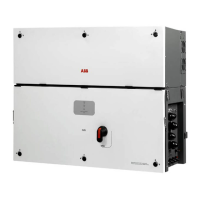
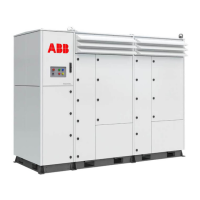
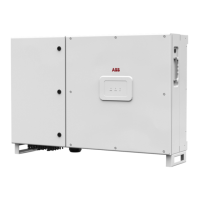
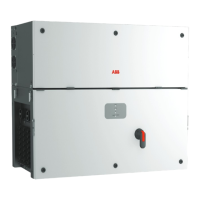
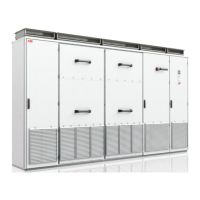
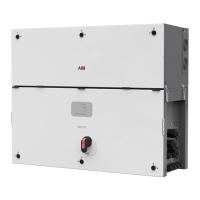
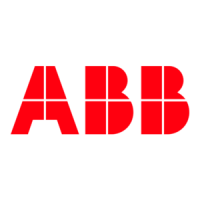
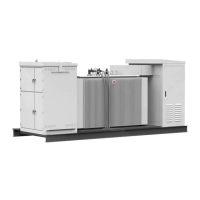
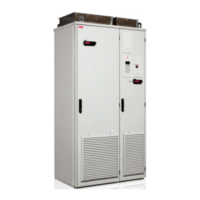

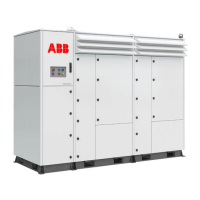
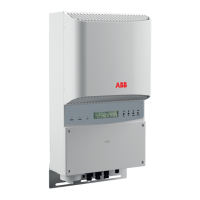
